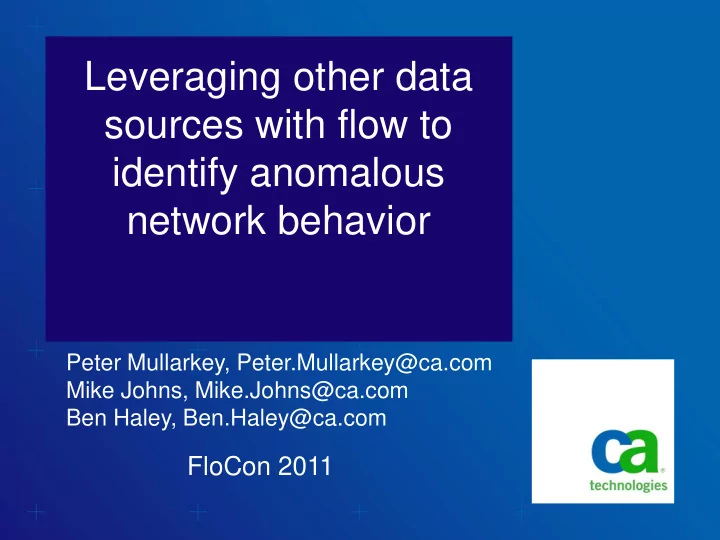

Leveraging other data sources with flow to identify anomalous network behavior Peter Mullarkey, Peter.Mullarkey@ca.com Mike Johns, Mike.Johns@ca.com Ben Haley, Ben.Haley@ca.com FloCon 2011
Goal and Approach —Goal: Create high quality events without sacrificing scalability —Approach: Create a system that − Is more abstract than a signature-based approach − Leverages domain knowledge more than a pure statistical approach − Makes use of all available data to increase event quality − Relies only on readily available data – no new collection
Architecture Correlation Controller Engine Anomaly GUI Storage Sensors Statistical Analysis Metric Metric Metric Storage Storage Storage
Sensors — Sensors are a level of abstraction above signatures − leveraging knowledge of network behavior —Sensors describe behavior to watch for − Is this host contacting more other hosts than usual? − Is this host transmitting large ICMP packets? TCP SYN TCP ACK TCP SYN ACK —Sensors can be created and modified in the field
Example Sensors — SYN-only Packet Sources − Looking at flows with SYN as the only flag. SYN flood, denial of service attack, worm infection — High Packet Fan Out − Looking at hosts talking to many more peers tan usual. Virus or worm infection — Large DNS and/or ICMP Packet Sources − Looking at volume/packet, compared to typical levels for these protocols. Data ex-filtration – discretely attempting to offload data from internal network to an external location — TTL Expired Sources − Network configuration issue – routing loops, heavy trace route activity — Previously Null Routed Sources − Traffic discovered from hosts that have had previous traffic null routed
Example Sensor (non-Flow data sources) — Incoming Discard Rate The Incoming Discard Rate sensor look for patterns where incoming packets were dropped even though they contained no errors. Can be caused by: Overutilization, Denial of service, or VLAN misconfiguration — Voice Call DoS This sensor looks for patterns where a single phone is called repeatedly over a short period of time. This type of attack differs from other Denial of Service (DoS) attacks and traditional IDS may not catch it because it is so low volume. It only takes about 10 calls per minute or less to keep a phone ringing all the time. — Packet Load This sensor looks for a pattern in bytes per packet to server. Applications running on servers generally have a fairly constant ratio between the number of packets they receive in requests for their service and the volume of those packets. This sensor looks for anomalous changes in that ratio.
SQL Interface to Metric Data (including flow) — Very helpful for exploring the data – to look for interesting patterns, and develop sensors — Example: top talkers (by flows) SELECT srcaddr as source, count(*) as flowsPerSrc, count(*)/ ((max(timestamp) - min(timestamp)) / 60 ) as avgPerMin FROM AHTFlows group by source order by flowsPerSrc desc limit 10
SQL Interface to Metric Data (including flow) — More in-depth example: looking at profiling SSL traffic (as a basis for identifying exfiltration) Select inet_ntoa(srcaddr) as srcHostAddr, count(if(dstport = 443, inbytes, 0)) as samples, count(distinct(dstAddr)) as numOfDestsPerSrcHost, min(if(dstport = 443, inbytes/inpkts, 0)) as minBytesPerPacketPerSrcHost, avg(if(dstport = 443, inbytes/inpkts, 0)) as avgBytesPerPacketPerSrcHost, std(if(dstport = 443, inbytes/inpkts, 0)) as stdBytesPerPacketPerSrcHost, max(if(dstport = 443, inbytes/inpkts, 0)) as maxBytesPerPacketPerSrcHost, sum(if(dstport = 443, inbytes, 0)) / sum(inbytes)as sslRatioPerSrcHost, group_concat(inet_ntoa(dstAddr)) as destAddrsPerSrcHost from AHTFlows where protocol = 6 and timestamp > (unix_timestamp(now()) - 30*60) group by hostAddr having sslBytes > 0 and numOfDestsPerSrcHost < 10 order by sslBytes desc
Correlation Engine —Multiple anomaly types for the same monitored item within the same time frame combine into a correlated anomaly —These can span data from disparate sources − NetFlow, Response Time, SNMP, etc —An index is calculated that aids in ranking the correlated anomalies
Types of Problems Found The developed system has found issues that are beyond single issue description —Spreading Malware —Router overload causing server performance degradation (Example #1) —Data exfiltration —Interface drops causing downstream TCP retransmissions —Unexpected applications on the network (Example #2)
Customer Example 1: Unexpected Performance Degradation Ny1-x.x.100.52
Customer Example 1: Unexpected Performance Degradation
Customer Example 2: What is really happening on your network?
Summary High quality anomalies can be found without sacrificing scalability —Key aspects − Embodying domain knowledge in sensors − Leveraging statistical analysis approach, separating domain knowledge from data analysis − Using simple, fast event correlation Effectiveness of approach has been shown by solving customer problems on real networks
Questions?
Backup Slides —Extra info slides
Customer Example 3: Malware Outbreak
Customer Example 3: Malware Outbreak
Customer Example 4: Retransmissions traced back
Statistical Analysis Methodology — Define anomaly as a sequence of improbable events — Derive the probability of observing a particular value from (continually updated) historical data − Example • Under normal circumstances values above the 90 th percentile occur 10 percent of the time — Use Bayes’ Rule to determine the probability that a sequence of events represents anomalous behavior ( | ) * ( ) p point anomaly p anomaly = ( | ) p anomaly point ( ) p point
Why Bayesian? Thresholding directly off of observations is difficult We wanted an approach that could take both time and degree of violation into account, so we threshold on probability
Customizable, pluggable Engines ( | ) * ( ) p point anomaly p anomaly = ( | ) p anomaly point + ( ( | ) * ( )) ( ( |~ ) * (~ )) p point anomaly p anomaly p point anomaly p anomaly p ( anomaly ) is the prior probability – either some starting value or the output from last time p(point|anomaly) & p(point | ~anomaly ) are given by probability mass functions – and are the basis for our customizable, pluggable engines Probability P(~anomaly | point) Probability P(anomaly | point) 0.01 Percentile(point) Percentile(point)
Motivation Less Scalable More Scalable Higher Quality Events Lower Quality Events “Behavior Per-metric thresholds Analysis” Baselining Intrusion Detection Systems Virus Scanners Packet Inspection Signature-Based Statistical Methods
Recommend
More recommend